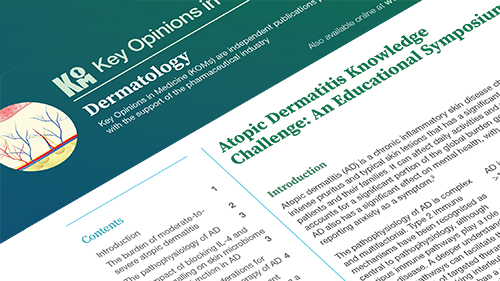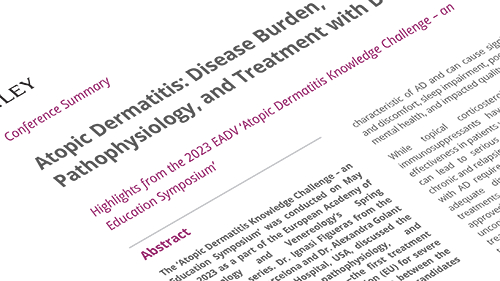Atopic Dermatitis and Prurigo Nodularis: Dupilumab Therapy and Disease Control
Highlights from the 32nd EADV Congress
Abstract
The 32nd European Academy of Dermatology and Venereology Congress was held between October 11th and 14th 2023 in Berlin, Germany. During the event, Prof. Stephan Weidinger, from the University Hospital Schleswig-Holstein, Germany, discussed the role of type 2 inflammation in the pathophysiology of atopic dermatitis (AD), followed by the mechanism and efficacy of dupilumab in treating AD. Prof. Emma Guttman-Yassky from the Icahn School of Medicine, USA, highlighted the different AD phenotypes and their treatment with dupilumab. Prof. Adam Friedman from The George Washington University School of Medicine & Health Sciences, USA, provided insights into the real-world studies and compared the findings to the clinical evidence of dupilumab treatment. In another panel, Prof. Martin Metz from the Charité – Universitätsmedizin Institute of Allergology, Germany discussed the similarities and differences between AD and prurigo nodularis (PN), concerning their clinical manifestations and pathologies. Dr. Andreas Pinter from the Goethe-University, Germany, and Dr. Raj Chovatiya, from the Feinberg School of Medicine, USA, reviewed the efficacy and safety of dupilumab in the management of AD and PN.
This article provides insights from the symposium, focusing on the pathophysiology of AD and PN, and the usage of dupilumab in treating both conditions. It also covers discussion on clinical studies and real-world data on the efficacy and safety of dupilumab.
Introduction
Atopic dermatitis (AD), or atopic eczema, is a chronic inflammatory skin disorder characterised by intense itching and recurrent eczematous lesions. It is highly prevalent among children and affects 2% to 10% of adults, worldwide1,2, leading to itching, skin pain, sleep disturbance, and overall impaired quality of life (QoL). Patients with AD have reported itch to be the most bothersome symptom and is often accompanied by an intense urge to scratch earning AD a common name of ‘itch that rashes’2. These patients often face psychosocial challenges, including disrupted relationships, embarrassment due to their appearance, and dysfunctional work life. AD also makes individuals susceptible to food allergies, asthma, allergic rhinitis, other immune-mediated inflammatory diseases, and mental health disorders like anxiety and depression1,2. AD treatment primarily involves topical corticosteroids and calcineurin inhibitors to manage remissions1, but systemic antipruritic therapies are required concerning the disease’s heterogeneity.
Prurigo nodularis (PN) is another inflammatory skin disease characterised by a chronic itch lasting for six weeks or more, accompanied by disseminated pruriginous lesions. Similar to AD, PN patients find itching to be the most bothersome symptom3. Despite having shared symptoms, AD and PN are distinct diseases and may co-exist in a single patient.
Type 2 inflammation and its role in AD and PN pathophysiology
Type 2 inflammation is a specialised immune response led by T helper 2 (Th2) cells that secrete interleukin 4 (IL-4), IL-5, IL-13, and IL-31 which in turn activate type 2 immunity, characterised by high immunoglobulin (Ig)E and eosinophil levels4. Dysregulated type 2 inflammation plays a key role in the pathogenesis of AD and PN. IL-4 in turn induces the production of IL-31, which leads to a dysregulated type 2 inflammatory reaction resulting in the vicious itch-scratch cycle4,5,6.
The chronic AD itches are results from abnormal neuro-immuno-epithelial crosstalk. Here, IL-4 plays a crucial role by stimulating the sensory neurons and promoting neuronal growth. IL-4 has a high affinity to IL-4 receptor α (IL-4Rα) expressed on Th0 and Th2 cells and maintains the type 2 immune response by strongly binding to IL-4Rα. However, IL-13 cannot bind to naïve and Th2 cells as they do not express its specific receptors, thereby confirming that IL-4 orchestrates the type 2 immune response and AD pathogenesis4,5,6.
One of the major reasons behind the chronic itch is the disruption of the skin barrier structure and function. IL-4-mediated inflammatory response disrupts the structure and composition of the barrier and causes dysbiosis with reduced microbial diversity predominated by Staphylococcus aureus. Furthermore, IL-4 induces apoptosis of endothelial cells and increases the membrane permeability, allowing plasma proteins like fibrinogens and fibronectin, to leak into the epidermis. S. aureus receptors adhere to fibronectin on the skin surface and colonise the epidermis, further increasing the susceptibility to other infections<sup>7,8</sup>.
Dupilumab and AD
Dupilumab is an effective treatment for moderate-to-severe AD in children, adolescents, and adults. It was approved for clinical use in the European Union and by The United States Food and Drug Administration. Commercially known as Dupixent, it is the first biologic that effectively targets the core pathology of AD, type 2 inflammatory response, thus combining clinical efficacy with safety. Dupilumab is a human IgG4 monoclonal antibody against IL-4Rα, produced by recombinant DNA technology. It binds to IL-4Rα and inhibits the signalling pathway activated by both IL-4 and IL-13 and downregulates the Th2 inflammatory cascade. Dupilumab is the only advanced systemic AD therapy that targets IL-4Rα leading to dual inhibition of IL-4 and IL-13. It must be noted that dupilumab is an effective immunomodulator and not a broad-spectrum immunosuppressant. Apart from AD, it has shown great effectiveness in treating other chronic inflammatory disorders such as PN, asthma, and eosinophilic esophagitis<sup>9.10</sup>. It is the only systemic therapy approved for treating adults with moderate to severe PN. The dual inhibition action of IL-4 and IL-13 pathways by dupilumab disrupts signalling pathways that stimulate sensory neurons, effectively mitigating chronic itch and improving QoL in AD patients<sup>11</sup>.
Biomarkers for AD<sup>12,13,14</sup>
AD diagnosis is mostly done by skin and blood of patients across all age groups. And, severity of this disease was determined based on the Eczema Area and Severity Index (EASI) score, which indicates the extent and severity of disease; the Pruritus Numerical Rating Scale (NRS), which indicates the intensity of itching; SCOring Atopic Dermatitis (SCORAD); Patient-Oriented Eczema Measure score, and total Global Individual Signs Score and Global Individual Signs Score components. The tape strip method of skin profiling is widely used for infants and toddlers owing to its non-invasive nature. RNA-sequencing of tape strips has revealed a set of differentially expressed genes (DEGs) specific to AD, such as Th2-related genes, lipid metabolisms genes, tight junction genes, and many more. Dupilumab effectively regulated identified DEGs, to alleviate the systemic Th2 immune response, further confirming its reproducible efficacy. Further, it showed efficient management of AD and reduction in symptoms in patients from different age groups (infants to older adults), racial groups, with varying disease severities, and across different sites in the body, such as in the neck and head. The identified biomarkers may be used for the early diagnosis of AD and rapid administration of individualised treatment.
Efficacy of dupilumab AD and PN
Across the phase three trials of SOLO 1 and SOLO 2, AD ADOL, and CHRONOS, dupilumab showed rapid persistent improvement in itch in both adolescents and adults<sup>15</sup>. LIBERTY AD CHRONOS, a one-year, randomised, double-blinded, placebo-controlled phase 3 trial, evaluated the long-term efficacy and safety of dupilumab when used with topical corticosteroids (TCS). The addition of 300 mg dupilumab, weekly once or once every two weeks to the standard TCS regime, showed a 4-point improvement in numerical score rating, indicating reduced itchiness, as early as at week 16 and greater improvement was observed at week 52. There was a three-fold increase in the proportion of patients who achieved the EASI-75 score in dupilumab group as compared to the placebo. Patients on dupilumab showed significant improvements in other measured parameters as well like SCORAD, IGA, and IBA PN-s, and also reported remarkable improvement in Dermatology Life Quality Index (DLQI)<sup>16</sup>. A similar trend of improvement was also seen in patients with PN, upon use of dupilumab, as demonstrated by the Pooled PRIME/PRIME2 study in adults, irrespective of their atopic history, with 70% of the patients achieving itch improvement or nodule clearance by week 24.
Different clinical studies including phase four BALISTAD and PELISTAD, have reported that dupilumab normalised transepidermal water loss (TEWL) in lesion skin<sup>17</sup>, lipid composition in skin<sup>16</sup>, expression of fibrinogen and fibronectin, and inhibited epidermal hyperplasia markers in children as young as 6 months and adults with AD. Dupilumab was also reported to rapidly decrease the density of S. aureus, which normalised skin microbiome, increased filaggrin, and restored sweat distribution. Furthermore, dupilumab also normalised the intraepidermal nerve fibre density in patients with AD. Overall, dupilumab effectively restored skin barrier function thereby improving the QoL, without increased risk of infections<sup>15</sup>.
Safety profile of dupilumab in treating AD and PN17,18
Dupilumab administration at 300 mg a week or 300 mg every two weeks, did not show any severe treatment-emergent adverse event (TEAE), even after a prolonged period of five years. LIBERTY AD OLE, an open-label extension study demonstrated that dupilumab exhibited a consistent safety profile through the parent trial and long-term usage. Very few patients discontinued the treatment due to an adverse event. The tolerability of the drug was consistent across all age groups from infants to adolescents to older adults aged 60 years or more. These findings make dupilumab the first systemic therapy for AD with clinical safety data for up to five years.
Dupilumab also displayed a similar consistent safety profile when used for the treatment of PN. Moreover, there were no discontinuations of treatments in the PN group owing to TEAEs.
Overall, dupilumab shows great potential as a long-term, advanced, systemic therapy for both AD and PN. The treatment regime is extremely patient- and clinician-friendly as it does not increase existing malignancies, reactivate tuberculosis infection, increase non-herpetic skin infections, or need laboratory monitoring or cardiovascular risk screening.
Real-world evidence on dupilumab efficacy
Real-world and registry studies resonate with the effectiveness and safety of dupilumab as demonstrated in clinical trials and studies. Real-world studies have been independently conducted worldwide, including both paediatric and adult populations. Clinical studies with up to three years follow-up, support the findings of dupilumab being remarkably effective and well-tolerated across all age groups. Patients have shown improved signs and symptoms, QoL, and a high rate of disease control.
Summary
- AD and PN are distinct inflammatory diseases with chronic itch as the most troublesome symptom.
- Type 2 inflammation, mediated by IL-4 and IL-13 plays a vital role in the pathophysiology of both AD and PN.
- IL-4 orchestrates the type 2 immune response.
- Dupilumab is an effective treatment strategy for AD and PN, as it inhibits both IL-4 and IL-13, thereby restricting the neuronal signalling leading to pruritic itch.
- Dupilumab reduces itch and other symptoms, increases QoL, normalises skin composition, resident microbiome, and skin barrier function.
- Dupilumab demonstrates consistent efficacy across a diverse range of AD pathologies including varied age groups, racial ethnicities, and anatomical locations.
- Dupilumab has demonstrated prolonged safety and well-tolerability up to 5 years in patients of all age groups, in both AD and PN treatments.
- Real-world evidence corroborates the clinical findings concerning the efficacy and safety profile of dupilumab in treating AD and PN.
References
- Weidinger, S., & Novak, N. (2016). Atopic dermatitis. The Lancet, 387(10023), 1109–1122.
- Silverberg, J. I., Mohawk, J. A., Cirulli, J., Nograles, K., Punzalan, J. C., Kelly, K. M., Kim, B., Guttman‐Yassky, E., & Lebwohl, M. (2023). Burden of disease and unmet needs in atopic dermatitis: results from a patient survey. Dermatitis, 34(2), 135–144.
- Pereira, M. P., Hoffmann, V., Weißhaar, E., Wallengren, J., Halvorsen, J. A., Garcovich, S., Miséry, L., Brenaut, E., Şavk, E., Потекаев, Н. Н., Lvov, A. N., Bobko, S., Szepietowski, J. C., Reich, A., Bożek, A., Legat, F. J., Metz, M., Streit, M., Serra‐Baldrich, E., . . . Zeidler, C. (2020). Chronic nodular prurigo: clinical profile and burden. A European cross‐sectional study. Journal of the European Academy of Dermatology and Venereology, 34(10), 2373–2383.
- Gandhi, N. A., Bennett, B. L., Graham, N. M., Pirozzi, G., Stahl, N., & Yancopouloš, G. D. (2015). Targeting key proximal drivers of type 2 inflammation in disease. Nature Reviews Drug Discovery, 15(1), 35–50.
- Beck, L. A., Cork, M. J., Amagai, M., De Benedetto, A., Kabashima, K., Hamilton, J. D., & Rossi, A. B. (2022). Type 2 inflammation contributes to skin barrier dysfunction in atopic dermatitis. JID Innovations, 2(5), 100131.
- Garcovich, S., Maurelli, M., Gisondi, P., Peris, K., Yosipovitch, G., & Girolomoni, G. (2021). Pruritus as a distinctive feature of Type 2 inflammation. Vaccines, 9(3), 303.
- Lee, Y. W., Kühn, H., Hennig, B., & Toborek, M. (2000). IL‐4 induces apoptosis of endothelial cells through the caspase‐3‐dependent pathway. FEBS Letters, 485(2–3), 122–126.
- Leung, D. Y., Bissonnette, R., Kreimer, S., Berdyshev, E., Bafna, S., Lyubchenko, T., Richers, B., Garcia, S., Ramirez-Gama, M., Hall, C. F., Xiao, O., Taylor, P. A., Boguniewicz, M., Levit, N. A., Agueusop, I., Zhang, A., & Goleva, E. (2023). Dupilumab inhibits vascular leakage of blood proteins into atopic dermatitis skin. The Journal of Allergy and Clinical Immunology: In Practice, 11(5), 1421–1428.
- Harb, H., & Chatila, T. (2019). Mechanisms of dupilumab. Clinical & Experimental Allergy, 50(1), 5–14.
- Dupixent | European Medicines Agency. (2017, November 10).
- Oetjen, L. K., Mack, M. R., Feng, J., Whelan, T. M., Niu, H., Guo, C., Chen, S., Trier, A. M., Xu, A., Tripathi, S., Luo, J., Gao, X., Yang, L., Hamilton, S., Wang, P. L., Brestoff, J. R., Brasington, R., Schaffer, A., Brombacher, F., . . . Kim, B. (2017). Sensory neurons co-opt classical immune signaling pathways to mediate chronic itch. Cell, 171(1), 217-228.e13.
- Berdyshev, E., Goleva, E., Bissonnette, R., Bronova, I., Bronoff, A. S., Richers, B., Garcia, S., Ramirez-Gama, M., Taylor, P. A., Praestgaard, A., Agueusop, I., Jurvilliers, P., Boguniewicz, M., Levit, N. A., Rossi, A. B., Zhang, A., & Leung, D. Y. (2022). Dupilumab significantly improves skin barrier function in patients with moderate‐to‐severe atopic dermatitis. Allergy, 77(11), 3388–3397.
- Guttman‐Yassky, E., Bissonnette, R., Ungar, B., Suárez‐Fariñas, M., Ardeleanu, M., Esaki, H., Suprun, M., Estrada, Y., Xu, H., Peng, X., Silverberg, J. I., Menter, A., Krueger, J. G., Zhang, R., Chaudhry, U., Swanson, B. N., Graham, N. M., Pirozzi, G., Yancopouloš, G. D., & Hamilton, J. D. (2019). Dupilumab progressively improves systemic and cutaneous abnormalities in patients with atopic dermatitis. Journal of Allergy and Clinical Immunology, 143(1), 155–172.
- Silverberg, J. I., Yosipovitch, G., Simpson, E. L., Kim, B., Wu, J. J., Eckert, L., Guillemin, I., Chen, Z., Ardeleanu, M., Bansal, A., Kaur, M., Rossi, A. B., Graham, N. M., Patel, N., & Gadkari, A. (2020). Dupilumab treatment results in early and sustained improvements in itch in adolescents and adults with moderate to severe atopic dermatitis: Analysis of the randomized phase 3 studies SOLO 1 and SOLO 2, AD ADOL, and CHRONOS. Journal of the American Academy of Dermatology, 82(6), 1328–1336.
- Blauvelt, A., De Bruin‐Weller, M., Gooderham, M., Cather, J. C., Weisman, J., Pariser, D. M., Simpson, E. L., Papp, K., Hong, H. C. H., Rubel, D., Foley, P., Prens, E. P., Griffiths, C., Etoh, T., Pinto, P. H., Pujol, R. M., Szepietowski, J. C., Ettler, K., Kemény, L., . . . Shumel, B. (2017). Long-term management of moderate-to-severe atopic dermatitis with dupilumab and concomitant topical corticosteroids (LIBERTY AD CHRONOS): a 1-year, randomised, double-blinded, placebo-controlled, phase 3 trial. The Lancet, 389(10086), 2287–2303.
- Pavel, A. B., Renert‐Yuval, Y., Wu, J., Del Duca, E., Diaz, A., Lefferdink, R., Fang, M. M., Canter, T., Rangel, S. M., Zhang, N., Krueger, J. G., Paller, A. S., & Guttman‐Yassky, E. (2020). Tape strips from early‐onset pediatric atopic dermatitis highlight disease abnormalities in nonlesional skin. Allergy, 76(1), 314–325.
- Silverberg, J. I., Lynde, C., Abuabara, K., Patruno, C., De Benedetto, A., Zhang, H., Thomas, R. B., Bégo-Le-Bagousse, G., Khokhar, F. A., Vakil, J., Marco, A. R., & Levit, N. A. (2023). Efficacy and safety of dupilumab maintained in adults ≥ 60 years of age with moderate-to-severe atopic dermatitis: Analysis of pooled data from four randomized clinical trials. American Journal of Clinical Dermatology, 24(3), 469–483.
- Beck, L. A., Deleuran, M., Bissonnette, R., De Bruin‐Weller, M., Galus, R., Nakahara, T., Seo, S. J., Khokhar, F. A., Vakil, J., Xiao, J., Marco, A. R., Levit, N. A., O’Malley, J. T., & Shabbir, A. (2022). Dupilumab provides acceptable safety and sustained efficacy for up to 4 Years in an open-label study of adults with moderate-to-severe atopic dermatitis. American Journal of Clinical Dermatology, 23(3), 393–408.




